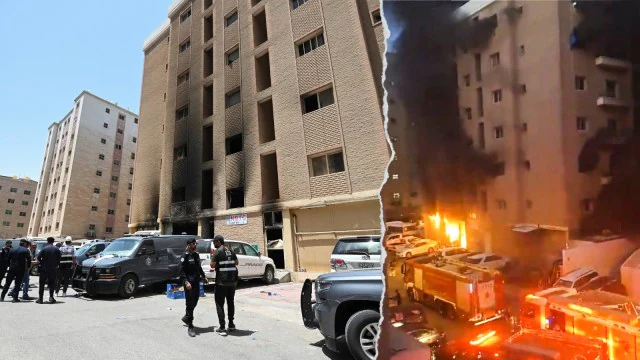Kuwait Introduction
The Kuwait block fire, a annihilating occurrence, captured universal consideration due to its scale, affect, and the reaction it earned. This appalling occasion not as it were highlighted the vulnerabilities in urban security but moreover incited noteworthy talks around fire security conventions, crisis reactions, and the part of administration in catastrophe administration. This comprehensive investigation points to dive into the subtle elements of the fire, its causes, results, and the broader suggestions for open security and policy.

Kuwait Background and Context
Kuwait, a well off Inlet country, is known for its advanced framework and fast urbanization. Be that as it may, like numerous quickly creating districts, it faces challenges in guaranteeing that security directions keep pace with development. The piece fire happened in a thickly populated private region, underscoring the dangers related with high-density urban living.
A enormous fire broke out in a private piece in the Al-Mangaf locale of Kuwait. The blast rapidly spread through the building, fueled by exceedingly combustible materials and exacerbated by solid winds. Onlookers detailed scenes of chaos as inhabitants attempted to elude, with a few caught in their flats due to smoke and flares blocking their exit routes.
Firefighters and crisis administrations were expeditiously dispatched, but the scale and escalated of the fire postured critical challenges. It took a few hours for the fire to be brought beneath control, and by at that point, the harm was extensive.
Causes of the Fire
Investigations into the fire uncovered different variables that contributed to the fast spread and seriousness of the blaze:
Building Materials: The utilize of non-fire-resistant materials in the development of the building altogether contributed to the fire’s spread. Numerous advanced developments, particularly in districts with quick urban development, regularly neglect rigid security standards.
Electrical Issues: Preparatory reports shown that the fire may have begun due to an electrical blame. Electrical fires are common in thickly populated buildings where wiring may be obsolete or disgracefully maintained.
Lack of Fire Security Measures: The building needed satisfactory fire security measures, such as fire alerts, sprinklers, and open fire exits. These exclusions demonstrated lethal, as inhabitants were not cautioned in time, and departure courses were insufficient.
High Populace Thickness: The building was domestic to a expansive number of inhabitants, numerous of whom were ostracize laborers. The tall thickness of individuals expanded the trouble of departure and likely contributed to the tall casualty rate.
Consequences of the Fire
The quick results of the Kuwait square fire were devastating:
Casualties: The fire come about in the appalling misfortune of over 50 lives, with numerous more harmed. The tall number of casualties highlighted the extreme affect of the fire and the challenges in crisis evacuation.
Displacement: Hundreds of inhabitants were uprooted, losing their homes and belonging. The relocation made an critical require for brief lodging and helpful assistance.
Psychological Affect: Survivors and the families of casualties confronted noteworthy mental injury. The occurrence cleared out a enduring affect on the community, with numerous people requiring long-term bolster and counseling.
Economic Misfortune: The fire caused significant financial misfortunes, counting the devastation of property and individual possessions. Moreover, businesses working inside the building or adjacent were influenced, disturbing neighborhood commerce.
Emergency Response
The reaction to the Kuwait piece fire included different organizations and highlighted both qualities and shortcomings in the country’s crisis preparedness:
Firefighting Endeavors: The Kuwait Fire Benefit Directorate (KFSD) reacted quickly, conveying various firefighting units and work force. In spite of their endeavors, the concentrated of the fire and the auxiliary challenges postured critical hurdles.
Medical Reaction: Healing centers and crisis restorative administrations were mobilized to treat the harmed. The scale of the occurrence strained restorative assets, but the reaction was for the most part compelling in giving fundamental care.
Community Bolster: Neighborhood communities and NGOs played a basic part in giving prompt help to those influenced. This included brief lodging, nourishment, and passionate support.
Government Activity: The Kuwaiti government started an examination into the causes of the fire and declared plans to audit and move forward fire security directions. Budgetary help and back were guaranteed to the casualties and their families.

Broader Suggestions and Lessons Learned
The Kuwait square fire has broader suggestions for urban security and catastrophe administration, both inside Kuwait and globally:
Reevaluation of Building Codes: The occurrence underscored the require for exacting building codes that prioritize fire security. This incorporates the utilize of fire-resistant materials and the execution of comprehensive fire security systems.
Improvement in Crisis Readiness: Viable crisis readiness includes not as it were having the fundamental assets but moreover guaranteeing that inhabitants are taught around fire security and departure procedures.
Regular Security Reviews: Normal reviews of buildings, particularly more seasoned developments, are significant to distinguish and correct potential fire risks. This incorporates overhauling electrical frameworks and guaranteeing compliance with security standards.
Community Engagement: Locks in communities in catastrophe readiness can upgrade flexibility. Community-led activities, such as fire drills and security preparing, can altogether diminish the affect of such incidents.
Policy Changes: Policymakers require to prioritize fire security in urban arranging. This incorporates creating clear rules and directions for modern developments and retrofitting existing buildings with fundamental security measures.
Global Collaboration: Nations can advantage from sharing best hones and collaborating on fire security inquire about. Worldwide organizations can play a part in advancing security measures and supporting capacity-building initiatives.
Conclusion
The Kuwait piece fire was a appalling occasion that brought to light basic issues in urban security and fiasco readiness. The misfortune of lives and the far reaching affect of the fire underscored the critical require for comprehensive security measures and strong crisis reaction frameworks. Moving forward, it is basic for governments, communities, and worldwide bodies to work together to anticipate such tragedies and guarantee more secure living situations for all. The lessons learned from this occurrence can direct future endeavors to improve fire security and secure helpless populaces.


